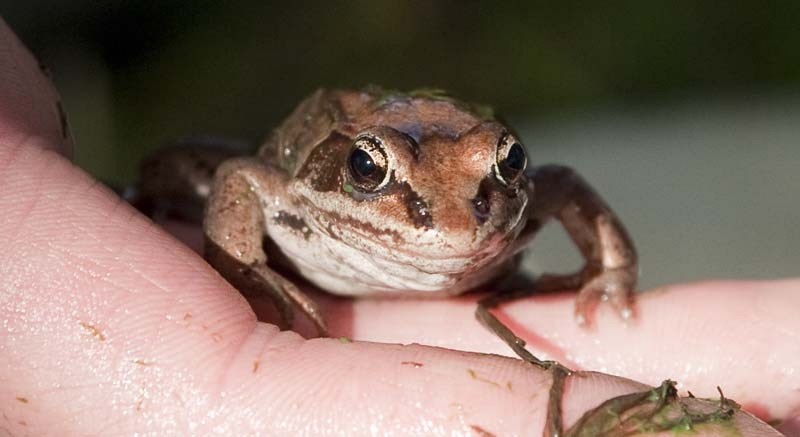Wood frogs are weird, man. It’s odd enough that they quack like ducks and freeze solid in the winter. But city resident and naturalist JoĂ«l Gervais tells me they can also explode.
Wood frogs are weird, man.
It’s odd enough that they quack like ducks and freeze solid in the winter. But city resident and naturalist JoĂ«l Gervais tells me they can also explode.
Like most frogs, male wood frogs will stimulate a female to release eggs by latching onto her and giving her a bear hug, Gervais says. Thing is, since every guy has the same idea, you often end up with a big wriggling ball of frog legs with a soon-to-be-crushed lady in the middle.
“This usually results in an exploded female with her entrails floating in the water surrounding her,” he says.
The wood frog is the frog you’re most likely to catch in Alberta, says Arthur Whiting, an instructor and frog researcher at the Northern Alberta Institute of Technology who studied frog calls in the Sturgeon last year.
Look for a frog that’s about five centimetres long, says Cynthia Paszkowski, professor of biological sciences and amphibian specialist at the University of Alberta, with smooth brown, grey or mahogany skin and a white belly. “They will always have a dark brown or black mask over their eyes,” she says, and won’t have warts like a toad. Some confuse it with the leopard frog, she adds, which is bigger, green, and spotted.
Wood frogs usually hang out in forests in search of bugs, Paszkowski says. They don’t have the super-long tongues of other frogs, but are known to use their hands to cram beetles and worms into their mouths.
This is one of the few times of the year that you can hear their strange, duck-like call, Whiting says. “If you can’t see ducks and you can hear ducks, there’s probably wood frogs calling.”
Wood frogs will have spent the last few months frozen under leaf litter, Whiting says, where it usually stays above -7 C all winter. By stuffing their cells full of sugar, the frogs can push water out of them, preventing them from exploding when they freeze. Come spring, they thaw out and come alive again. Researchers are now studying how the frogs manage this feat of cryogenics in order to figure out how to preserve human organs for longer periods.
Prior to freezing, Whiting says the frogs will have jacked up their hormones so that they’re ready to mate as soon as they defrost. “They’ve been horny since September.”
Small wonder, then, that the frogs will latch onto anything that moves – females, males, tiger salamanders, even your hand. “They have one thought, and it’s between a ‘S’ and a ‘X,’” Whiting says.
This is probably the best time of year to spot wood frogs, Whiting says, as they’ll all have gathered at local ponds and rivers to mate. “They’re called explosive breeders,” he notes, as they get all their mating done at once in a short period of time – two weeks, in this case.
Males will gather at the ponds first, calling to draw in ladies who gradually trickle in. The ladies are usually outnumbered, Paszkowski says, so they usually get mobbed.
Here’s where the hugging comes in. Like most frogs, the wood frog engages in amplexus, a practice where the male clamps onto the female’s back so no one else can fertilize her eggs. All the guys have the same idea, so you’ll often see five to six guys on one girl at once. “Males will (sometimes) squeeze the female hard enough that they cause them to burst,” she notes, releasing the eggs but killing the female.
The result is a softball-sized mass of eggs that floats in the water, Paszkowski says. Some ponds will have hundreds of them. The females usually leave after mating, while males might stick around to mate some more.
For the rest of the year, wood frogs can be tough to find, as they spend most of their time sitting around. You’ll often spot them hopping away from you as you walk along a riverbank, Paszkowski says, or making tiny ripples while croaking in the water. Your next best chance to spot lots of them will be this July, when most of the eggs will have hatched and grown up.
“They’re a handsome little frog,” Paszkowski says of wood frogs, and are very easy to work with. They also live everywhere, making them sort of the representative amphibian of Alberta.
And they’re really, really odd.
Wood frog
Name: <br />Lithobates sylvaticus (formerly Rana sylvatica).<br />
Appearance:<br />Small brown, grey or mahogony frog with smooth skin, white belly and brown/black mask over eyes.<br />
Commonly seen:<br />In woods near water or in ponds, sitting around.<br />
Occasionally confused with:<br />The leopard frog, which is green, twice as big, and has giraffe-like spots.<br />
Fun fact:<br />They can freeze solid in the winter and not die.
Wild St. Albert
Like wildlife? So do we! Every second Wednesday the Gazette profiles a reasonably common wild creature in the St. Albert region. Birds, beasts, bugs, fish … so long as it's alive and kicking, we'll feature it. <br /><br />Got a creature you'd like to see profiled? Send your suggestions to [email protected].




